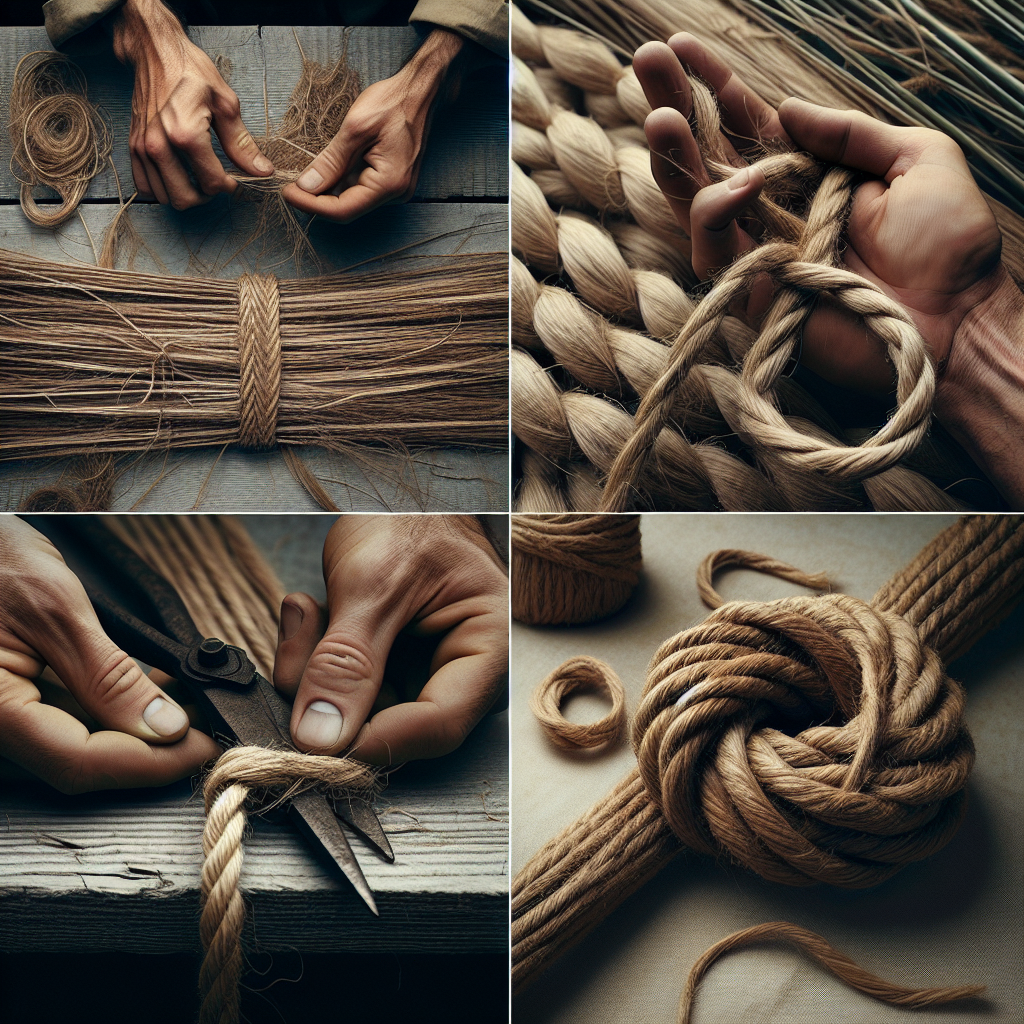Imagine you find yourself in a survival situation with no access to commercial ropes. Don’t panic! In this article, you will learn a skill that could save your life – how to make rope from natural materials. From grasses and vines to tree bark and animal hides, we will explore the diverse range of materials you can use to create strong and reliable rope. Get ready to tap into your resourcefulness and embrace the ancient art of rope-making.
Materials needed
To make rope from natural materials, you will need the following:
Natural fibers
The first thing you will need is natural fibers. These can be obtained from various sources such as plants and animals. Some common natural fibers used for rope-making include flax, sisal, hemp, yucca, nettle, silk, wool, and sinew.
Scissors or knife
A pair of scissors or a sharp knife will be necessary for harvesting and cutting the natural fibers. Make sure they are sharp to ensure clean and even cuts.
Tape measure
A tape measure will come in handy to measure the length of the fibers as well as to ensure equal lengths for an even rope.
Water
Water is needed for the preparation and processing of the natural fibers. It helps in softening and cleaning the fibers.
Bowl or bucket
You will need a bowl or bucket to soak the natural fibers in water. It should be large enough to accommodate the fibers you plan to use.
Soap
Soap is necessary for cleaning the natural fibers and removing any dirt or impurities they may contain. Natural and mild soaps are recommended to avoid damaging the fibers.
Preparing the natural fibers
Before you can start twisting the fibers into rope, it is important to properly prepare them. Here are the steps involved in preparing the natural fibers for rope-making:
Harvesting the fibers
Depending on the type of natural fibers you are using, you will need to harvest them from their respective sources. For example, flax fibers can be obtained by harvesting the stems of flax plants, while sisal fibers can be collected from the leaves of Agave plants.
Sorting and cleaning the fibers
Once you have harvested the fibers, it is important to sort them and remove any undesirable parts. This may include removing leaves, seeds, or any other debris. After sorting, the fibers should be thoroughly cleaned to remove dirt and impurities.
Drying the fibers
After cleaning, the fibers need to be dried before they can be twisted into rope. Drying can be done by hanging the fibers in a well-ventilated area or by using a gentle heat source. Make sure the fibers are completely dry before proceeding to the next step.

Twisting the fibers
Now that you have prepared the natural fibers, it’s time to start twisting them into rope. There are different methods you can use for twisting, depending on the desired thickness and strength of the rope.
Preparation
Before you begin twisting, make sure you have measured and cut the fibers to the desired length. This will ensure that all strands of the rope are equal in length.
Twisting method 1: Single-ply rope
To make a single-ply rope, take a bundle of fibers and twist them in a clockwise direction. This can be done by rolling the fibers between your hands or by using a twisting tool. Continue twisting until the fibers are tightly twisted together.
Twisting method 2: Three-ply rope
For a stronger rope, you can use the three-ply method. Divide the fibers into three equal bundles and twist each bundle in a clockwise direction. Once each bundle is twisted, twist the three bundles together in a counter-clockwise direction.
Twisting method 3: Braiding
Another method for making rope is braiding. Take three or more bundles of fibers and interweave them in an over-under pattern. This will create a sturdy and attractive rope.
Adding strength and durability
To enhance the strength and durability of your homemade rope, there are a few additional steps you can take.
Heat treatment
Heat treatment involves exposing the twisted rope to heat, which helps to set the twist and make the rope more resilient. This can be done by passing the rope through a flame or by using a heat source like a hairdryer.
Applying natural coatings
To protect the rope from weathering and wear, you can apply natural coatings such as beeswax or linseed oil. These coatings will help to seal the fibers and prevent them from becoming brittle or breaking.

Creating a rope-making device
While you can make rope by hand, using a rope-making device can make the process easier and more efficient. Here are two options for creating a rope-making device:
Using a rope-making machine
If you plan to make rope regularly, investing in a rope-making machine can be a good option. These machines are designed to twist fibers into rope quickly and with minimal effort.
Making a simple rope-making tool at home
If you prefer a DIY approach, you can create a simple rope-making tool using basic materials. One option is to use a wooden dowel or rod and attach hooks or clamps to hold the fibers in place while twisting.
Making rope from plant fibers
Plant fibers are a popular choice for making homemade rope due to their availability and versatility. Here are some examples of rope you can make from plant fibers:
Twine from flax fibers
Flax fibers can be twisted into twine, which is a thin and strong rope. Flax twine is used for various applications such as gardening, crafting, and sewing.
Sisal rope from Agave leaves
Agave leaves contain long and durable fibers that can be twisted into strong sisal rope. Sisal rope is commonly used for agricultural and industrial purposes.
Hemp rope from hemp fibers
Hemp fibers are known for their strength and durability, making them ideal for rope-making. Hemp rope has a wide range of applications, including construction, boating, and camping.
Yucca cordage from Yucca leaves
Yucca leaves can be processed to extract strong fibers, which can then be twisted into rope. Yucca cordage is commonly used in traditional crafts and outdoor activities.
Nettle cordage from nettle fibers
Despite their stinging reputation, nettle fibers can be used to make cordage. Nettle cordage is known for its strength and is often used in survival situations.
Making rope from animal fibers
Animal fibers can also be used to make rope. Here are a couple of examples:
Silk rope from silkworm cocoons
Silk is a luxurious and strong fiber that can be spun into a delicate rope. Silk rope is often used for decorative purposes or in specialized applications such as jewelry-making.
Wool yarn from sheep wool
Sheep wool can be spun into yarn, which can then be used to make rope. Wool rope is warm, soft, and has good insulation properties, making it suitable for various purposes.
Sinew cordage from animal tendons
Sinew, which is the strong and elastic connective tissue found in animal tendons, can be used to make cordage. Sinew cordage has been used by indigenous cultures for centuries and is known for its strength and durability.
Making rope from other natural materials
In addition to plant and animal fibers, there are other natural materials that can be used to make rope.
Vine rope from grapevines
Grapevines, with their long and flexible stems, can be twisted into rope. Vine rope can be used for various purposes such as gardening, decoration, or even as an emergency rope.
Bark fiber rope from tree bark
Certain tree barks can be processed to obtain fibers, which can then be twisted into rope. Bark fiber rope is often used for traditional crafts and natural building projects.
Using natural dyes for enhanced aesthetics
If you want to add some color and visual appeal to your homemade rope, you can use natural dyes. Here’s how you can dye your rope using natural sources:
Choosing natural dye sources
Some common sources of natural dyes include plants, fruits, vegetables, and even insects. Examples of natural dyes include onion skins, beetroot, turmeric, and indigo.
Preparing the natural dyes
To prepare the natural dyes, you will need to extract the color from the chosen source. This can be done by boiling or soaking the dye material in water or another liquid.
Dyeing the rope
Once the natural dye has been prepared, you can immerse your rope in the dye bath and let it soak for a period of time. The longer you leave the rope in the dye, the more intense the color will be. After dyeing, rinse the rope thoroughly and let it dry.
Uses of homemade rope
Homemade rope has a wide range of practical uses. Here are a few examples:
Survival and outdoor activities
Homemade rope can be invaluable in survival situations or during outdoor activities such as camping, hiking, or fishing. It can be used for shelter construction, securing items, creating snares or traps, and much more.
Crafts and DIY projects
Rope made from natural materials has a rustic and authentic beauty that can enhance various crafts and DIY projects. It can be used for macrame, weaving, jewelry-making, or as a decorative element in home decor.
In conclusion, making rope from natural materials is a rewarding and environmentally friendly skill. By using simple tools and techniques, you can transform natural fibers into strong and versatile rope. Whether you need it for practical purposes or creative endeavors, homemade rope offers endless possibilities. So, why not give it a try and start creating your own homemade rope today?

